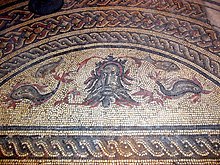| Fordington mosaic | |
|---|---|
 The Fordington mosaic in 2023 The Fordington mosaic in 2023 | |
| Artist | Dorchester School of Mosaicists |
| Year | 2nd century AD |
| Type | Mosaic |
| Subject | Oceanus |
| Dimensions | 715 cm × 480 cm (23.5 ft 2 in × 15.6 ft 189 in) |
| Condition | Partially complete |
| Location | Dorset County Museum, Dorchester |
The Fordington mosaic, also known as the Fordington High Street mosaic, is a Roman floor mosaic from the 2nd century AD, found in Fordington, Dorchester in England, in what was once Durnovaria; it is now on display at the Dorset Museum. It depicts Oceanus, marine life, and the ocean.
History
 The Fordigton mosaic being excavated in October 1927
The Fordigton mosaic being excavated in October 1927 Mosaicists Giomeria Zanetter (left) and Sidney Smith (right) with the Dorset Museum curator Captain John Edward Acland (middle), celebrating the final completion of the laying of the mosaic on 5 December 1927
Mosaicists Giomeria Zanetter (left) and Sidney Smith (right) with the Dorset Museum curator Captain John Edward Acland (middle), celebrating the final completion of the laying of the mosaic on 5 December 1927
Roman history
The Fordington mosaic was created by the Dorchester School of Mosaicists during the 2nd century AD (previously believed to have been created during the 4th century AD); it is believed that they created this mosaic due to their specific style of theming mosaics around sea gods and marine life. It was created for a town house on the outskirts of Durnovaria (which was located near 16 High Street, Fordington) and was a pavement mosaic.
The town house was then likely demolished shortly after the Romans left England around 410 AD as no archaeological remains that pre-date the post-Medieval period were identified from the site of the town house, suggesting the house was abandoned.
Modern history
The Fordington mosaic was discovered in 1903 on the site of Lott & Walne's Fordington foundry, and it was excavated in October 1927 with the help of poet Thomas Hardy, who as a result of excavating the mosaic became ill and died shortly after. The mosaic was lifted from a pit which reached around 2 metres (6.6 ft) in depth.
The mosaic was subsequently donated to the museum in November 1927 by Proprietors J. J. Walne and O.C. Vidler and was installed into the floor of the Dorset Museum by Giomeria Zanetter and Sidney Smith (the completion date of the mosaic installation was 5 December 1927).
The mosaic stayed in the floor of the museum it was dismantled and moved onto the Atrium wall of the museum shortly before the museum reopened in May 2021; the conservation work was undertaken by Lee Kimber, Richard Ball and Brian Bentley.
Description

The mosaic is incomplete, with parts of the lower section of the mosaic no longer existing today, and its design consists of a head of Oceanus, two dolphins and red-finned fish, while six red tesserae of a figure once occupying the central octagon are also present.
It has been described as being identical to pavement mosaics of a similar date found at Bignor and Cirencester and it also measures 715 cm × 480 cm (23.5 ft 2 in × 15.6 ft 189 in).
References
- Cosh, Stephen R. (2008). Mosaics from Buildings 13 and 6 (PDF) (978-1-874350-46-0 ed.). Wessex Arch. p. 4.
- Cosh, S. R. and Neal, D. S., (2006), Roman Mosaics of Britain: Volume II: South-west Britain, London, Society of Antiquaries
- ^ "Fordington mosaic". www.wessexmuseums.org.uk. Retrieved 4 August 2024.
- "Roman mosaics in Dorchester". www.thejoyofshards.co.uk. Retrieved 4 August 2024.
- ^ "16 HIGH STREET FORDINGTON CSO, DORCHESTER, DORSET, ARCHAEOLOGICAL OBSERVATIONS AND RECORDING". archaeologydataservice.ac.uk. Retrieved 4 August 2024.
- ^ 'Plate 225: Roman Mosaics in Dorchester and Weymouth', in An Inventory of the Historical Monuments in Dorset, Volume 2, South east( London, 1970), British History Online https://www.british-history.ac.uk/rchme/dorset/vol2/plate-225 .
- ^ "How do you move a 2000-year-old mosaic without breaking it?". www.hardysociety.org. Retrieved 4 August 2024.
- Bellamy, P. S. (2002). 16 HIGH STREET FORDINGTON CSO, DORCHESTER, DORSET, ARCHAEOLOGICAL OBSERVATIONS AND RECORDING. Terrain Archaeology. https://doi.org/10.5284/1031849.
- "Conservators re-install Mosaic in Museum". www.dorsetmuseum.org. 2 December 2020. Retrieved 4 August 2024.
- ^ "Reinstallation of the Fordington Mosaic at Dorset Museum". www.clivedenconservation.com. Retrieved 4 August 2024.